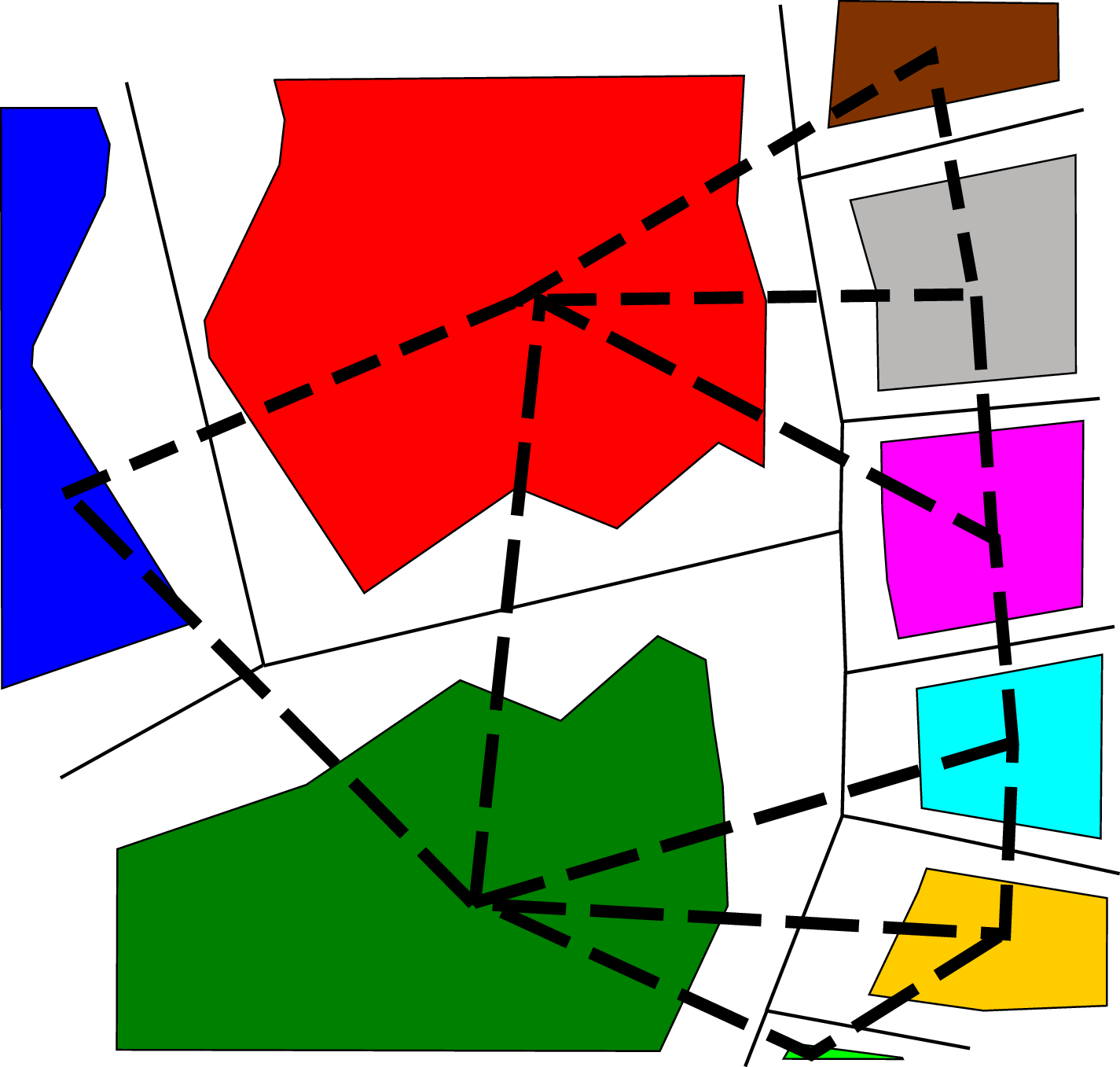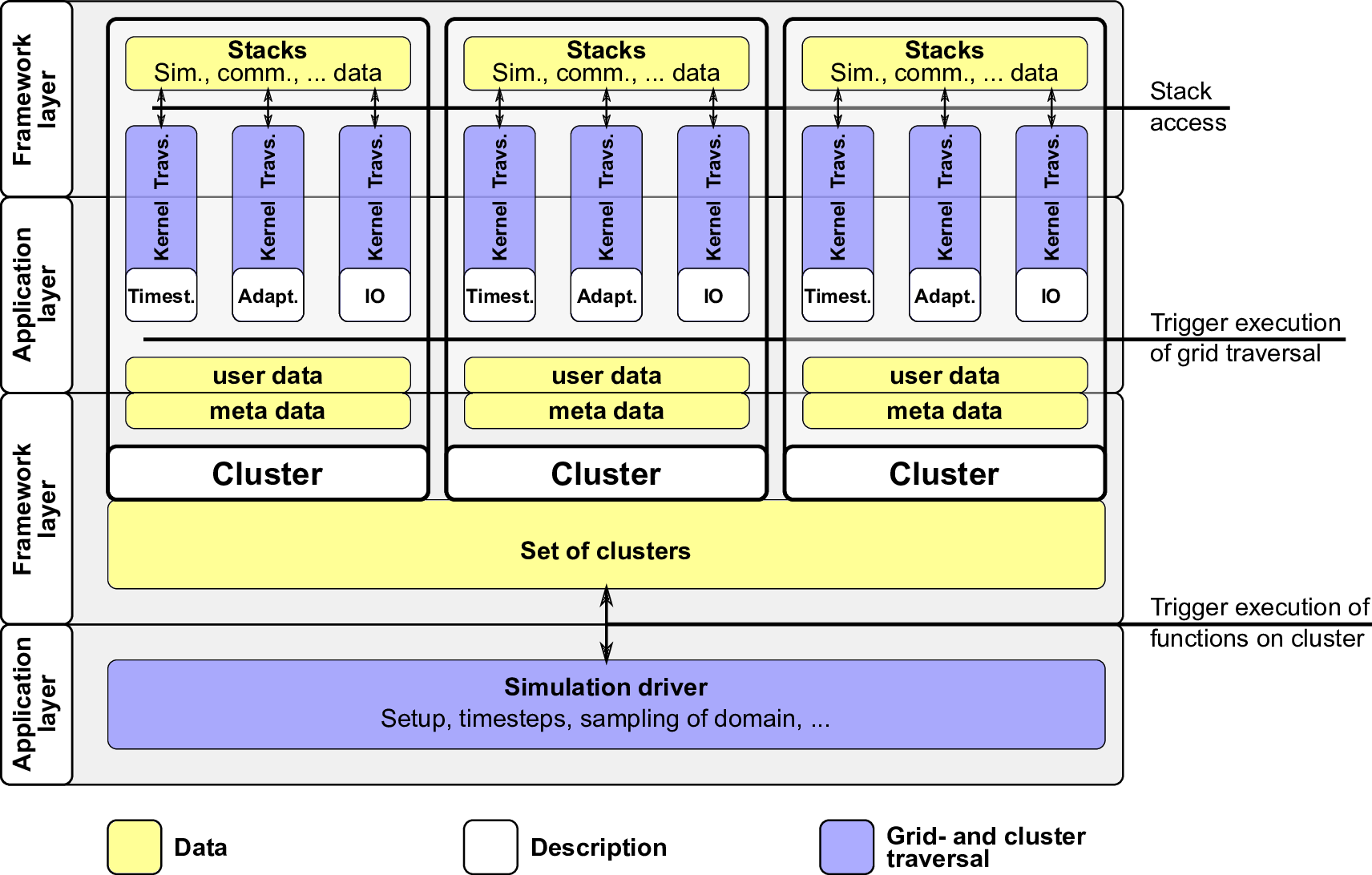
Based on the previous sections which gave a description on our domain decomposition approach and the communication between partitions, we now describe implementation details of our parallelization approach: how to store and manage partitions. This finally leads to an efficient clustering of the grid as suggested in different contexts such as cluster-based local time stepping [CKT09] and clustering based on intervals of one-dimensional representations of SFCs preserving the locality of multi-dimensional grid traversals [MJFS01]. With our dynamic adaptive grid, we extend these ideas to a dynamic clustering.
We start with our definition of a cluster by its data storage, grid management, communication meta information and traversal meta information properties:

For cluster-based local time stepping [CKT09], a decomposition of the domain in non-overlapping bulks with communication schemes capable of independent time steps was suggested, see Fig. 5.8. Since our development yields the same possibilities with a domain decomposition based on the heuristic of the Sierpiński SFC, we continue to use the terminology cluster, referring to a partitioning and software design fulfilling the previously mentioned properties.
With clustering at hand, we introduce a parallel framework design with a top-down approach by assembling domains with a set of clusters: First, we encircle the simulation data, the grid traversals as well as the corresponding kernels from the serial framework design (see Fig. 4.12) into a cluster container. A sketch of the resulting structures and abstractions inside such a container are depicted in Fig. 5.9.

For multiple clusters, we then extend this serial cluster-based framework design as it is depicted in Fig. 5.10. We continue with a top-down description under consideration of the serial framework design from Fig. 4.12:
The dynamical creation and deletion of clusters demands for an efficient cluster management data structure. Such an efficient management can be e.g. achieved with (double-)linked lists, vectors and maps. All these containers represent a set which stores the clusters. With our dynamic cluster generation based on subtree, we keep the recursive structure and use a binary tree structure, the cluster tree, to insert and remove clusters.
In case of a cluster split, two nodes are attached to the formerly leaf node and the cluster data is initialized at both leaf nodes.
For clusters stored at two leaves sharing the same parent, a join operation creates new cluster data at the parent node. Here, we can also reuse the cluster storage of one children to avoid copy operations. After joining two clusters, both leaf nodes are removed.
See Section 5.5 for a detailed description of dynamic clustering. An example of a cluster set based on a tree is given in Fig. 5.11.
Regarding the base triangulation which allows us to assemble domains with triangles being their building blocks (see Section 5.4), we follow the idea from p4est [BWG11] and combine multiple cluster trees at the leaf of a super-cluster tree. This extends the cluster tree to a forest of trees, a cluster forest, embedded into the super-cluster tree. We avoid joining clusters which were not created by a cluster split, i.e. initially belonging to the base triangulation. Here, we limit the cluster-join operations by considering the depth of the cluster in the super-cluster tree. For sake of convenience, we continue referring to the super-cluster tree as the cluster tree.
For identifying each cluster uniquely, we generate unique ids directly associated to the cluster’s placement in the cluster tree. This is based on the parent’s unique id for a split operation and childrens’ unique ids for join operation.
The cluster tree root id is initially set to 1b with the subscript b denoting binary number notation. With the id of the parent node stored in parentId, the first child’s id traversed by the SFC and the second child’s id following the first child is given by


This recursive unique id generation also provides information on the placement of the cluster within the tree. This feature is used for cluster-based data migration in Section 5.10.3 to update adjacency information about cluster stored on the same MPI node.
Furthermore these unique ids inherently yield an order of the cluster along the SFC. Given id1 and id2, we can compute the order with the following algorithm: for each unique id, the depth of the cluster in the cluster tree is given with



Alternative approaches would be e.g. based on a mix of MPI ranks and the MPI-node-local cluster enumeration. This also leads to properties which can be similarly used in the next sections. However, we decided to use the approach described above, since this unique id gets beneficial if searching for a cluster in the cluster tree.